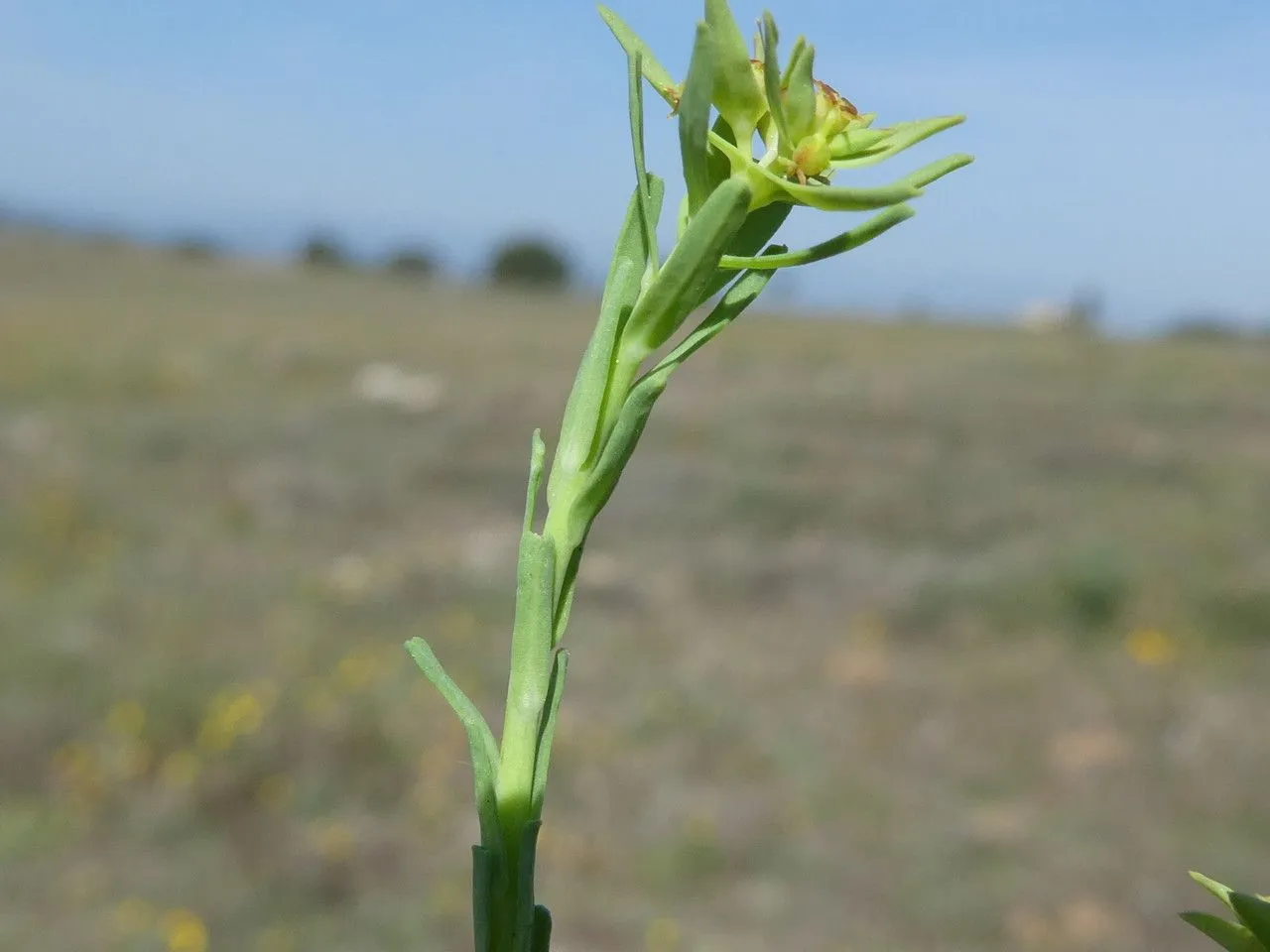
Author: L.
Bibliography: Sp. Pl.: 456 (1753)
Year: 1753
Status: accepted
Rank: species
Genus: Euphorbia
Vegetable: False
Observations: Macaronesia, Europe, Medit. to Iran
Euphorbia exigua, commonly known as Dwarf spurge, is a modest yet fascinating member of the diverse Euphorbiaceae family. First described scientifically by Carl Linnaeus in 1753 in “Species Plantarum”, this petite plant has intrigued botanists and plant enthusiasts alike for centuries.
Dwarf spurge is a small, herbaceous annual plant recognized for its slender, often slightly reddish stems and diminutive size. Typically, it grows to a height of 10-30 cm. Its leaves are linear to narrowly lanceolate, smooth in texture, and alternately arranged, contributing to its delicate appearance. This plant’s flowers are equally modest, characterized by their greenish or yellow tinge, which blend seamlessly with the foliage. The inflorescences are cyathia, a common trait among members of the Euphorbia genus, where the flowers are enclosed within a cup-like structure formed by fused bracts.
This plant’s native range extends from Macaronesia across Europe and the Mediterranean, stretching as far east as Iran. It thrives in diverse habitats ranging from rocky hillsides and open grasslands to roadsides and agricultural fields. The adaptability of Euphorbia exigua to various environmental conditions underscores its resilience and widespread presence.
Despite its diminutive size, Dwarf spurge plays a role in its ecosystem, often acting as a pioneer species in disturbed soils, where it helps in soil stabilization and provides a habitat for various small insects. However, it’s important to note that, like many spurges, Euphorbia exigua contains a milky latex that can be irritating to the skin and toxic if ingested, necessitating careful handling.
The modest charm and ecological resilience of Euphorbia exigua make it a plant of interest not just for botanists but also for those interested in the balance and diversity of natural ecosystems. Its wide distribution and adaptability highlight the plant’s ability to thrive under varying conditions, marking it as a true survivor in the plant kingdom.
Eng: dwarf spurge, hierbecilla traidora, small spurge
Deu: kleine wolfsmilch
Dan: liden vortemælk
Fra: euphorbe exiguë, euphorbe fluette
Spa: hierbecilla traidora, lechetrezna romeral, lechetrezna tonta, lechetreznilla romeral
Nld: kleine wolfsmelk
Lav: mazais dievkrēsliņš
Fin: pikkutyräkki
Swe: pikkutyräkki, småtörel
Ces: pryšec drobný
Nob: småvortemelk
Nno: småvortemjølk
Est: väke piimalill
Por: ésula meno
Cym: corlaethlys, fflamgoed bach yr ŷd, fflamgoed fiddil flaenfain
En: Dwarf spurge, Hierbecilla traidora, Small spurge
Ar: لبين (لِبين)، لبينه (لِبيْنه), فربيون صغير
Be: Малачай мізэрны
Bg: Малка млечка
Ca: Eufòrbia exigua, Lletera exigua, Lleteresa, Lleterola exigua, Lleterola, Mal d’ulls
Cs: Pryšec drobný
Da: Liden Vortemælk
Nl: Kleine wolfsmelk
Et: Väike piimalill, Väke piimalill
Fi: Pikkutyräkki
Fr: Euphorbe exiguë, Euphorbe fluette, Petite euphorbe, Petite ésule
De: Kleine Wolfsmilch
He: חלבלוב צר-עלים
It: Euforbia sottile
Lv: Mazais dievkrēsliņš
Nb: Småvortemelk
Nn: Småvortemjølk
Pl: Wilczomlecz drobny
Pt: Ésula meno
Pt-br: Leiteira-menor
Ru: Молочай малый
Sk: Mliečnik drobný
Es: Lechetrezna romeral, Lechetrezna tonta, Lechetreznilla romeral, Hierbecilla traidora, Euforbio enano, Hierba traidora, Lechetreznilla, Sonajillas lecheras
Sv: Småtörel, Pikkutyräkki
Uk: Молочай дрібненький
Cy: Corlaethlys, Fflamgoed Bach yr Ŷd, Fflamgoed Fiddil Flaenfain
Taken Jun 5, 2018 by Llandrich anna (cc-by-sa)
Taken May 20, 2021 by Llandrich anna (cc-by-sa)
Taken Apr 1, 2021 by Llandrich anna (cc-by-sa)
Taken Apr 24, 2018 by Llandrich anna (cc-by-sa)
Taken May 7, 2017 by Carlos Villasante (cc-by-sa)
Taken Apr 14, 2016 by Tela Botanica − Liliane ROUBAUDI (cc-by-sa)
Taken Apr 14, 2016 by Tela Botanica − Liliane ROUBAUDI (cc-by-sa)
Taken Jun 21, 2019 by Genghis Attenborough (cc-by-sa)
Taken Jun 5, 2018 by Llandrich anna (cc-by-sa)
Taken May 20, 2021 by Llandrich anna (cc-by-sa)
© copyright of the Board of Trustees of the Royal Botanic Gardens, Kew.
© copyright of the Board of Trustees of the Royal Botanic Gardens, Kew.
© copyright of the Board of Trustees of the Royal Botanic Gardens, Kew.
Taken Jan 1, 1800 by Tela Botanica − Thierry Pernot (cc-by-sa)
Taken Mar 9, 2019 by valooo94 (cc-by-sa)
Taken Apr 15, 2004 by Photoflora – Benoit BOCK (©)
Taken Apr 1, 2021 by Llandrich anna (cc-by-sa)
Taken May 20, 2021 by Llandrich anna (cc-by-sa)
Taken Apr 13, 2021 by loona teffot (cc-by-sa)
Taken Feb 25, 2020 by enzo Magalhaes (cc-by-sa)
Taken Apr 24, 2018 by Llandrich anna (cc-by-sa)
Taken May 20, 2021 by Llandrich anna (cc-by-sa)
Taken May 7, 2017 by Carlos Villasante (cc-by-sa)
Taken Apr 14, 2016 by Tela Botanica − Liliane ROUBAUDI (cc-by-sa)
Taken Apr 2, 2017 by Tela Botanica − Errol VELA (cc-by-sa)
Taken Apr 20, 2015 by Tela Botanica − Genevieve BOTTI (cc-by-sa)
Taken May 4, 2021 by Stéphane Mars (cc-by-sa)
Taken Apr 1, 2021 by Llandrich anna (cc-by-sa)
Taken Apr 24, 2015 by Tela Botanica − Liliane Roubaudi (cc-by-sa)
Taken Apr 24, 2015 by Tela Botanica − Liliane Roubaudi (cc-by-sa)
Taken Sep 23, 2021 by Jenn (cc-by-sa)
Taken Apr 24, 2015 by Tela Botanica − Liliane Roubaudi (cc-by-sa)
Taken Jun 21, 2019 by Genghis Attenborough (cc-by-sa)
Growth habit: Forb/herb
Bloom months: [‘apr’, ‘may’, ‘jun’, ‘jul’, ‘aug’, ‘sep’, ‘oct’]
Family: Myrtaceae Author: (F.Muell.) K.D.Hill & L.A.S.Johnson Bibliography: Telopea 6: 402 (1995) Year: 1995 Status:…
Family: Rubiaceae Author: Pierre ex A.Froehner Bibliography: Notizbl. Bot. Gart. Berlin-Dahlem 1: 237 (1897) Year:…
Family: Sapindaceae Author: Koidz. Bibliography: J. Coll. Sci. Imp. Univ. Tokyo 32(1): 38 (1911) Year:…
Family: Asteraceae Author: A.Gray Bibliography: Pacif. Railr. Rep.: 107 (1857) Year: 1857 Status: accepted Rank:…
Family: Fabaceae Author: Medik. Bibliography: Vorles. Churpfälz. Phys.-Ökon. Ges. 2: 398 (1787) Year: 1787 Status:…
Family: Aspleniaceae Author: (Cav.) Alston Bibliography: Bull. Misc. Inform. Kew 1932: 309 (1932) Year: 1932…